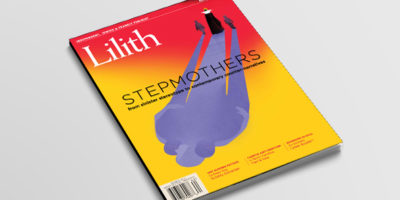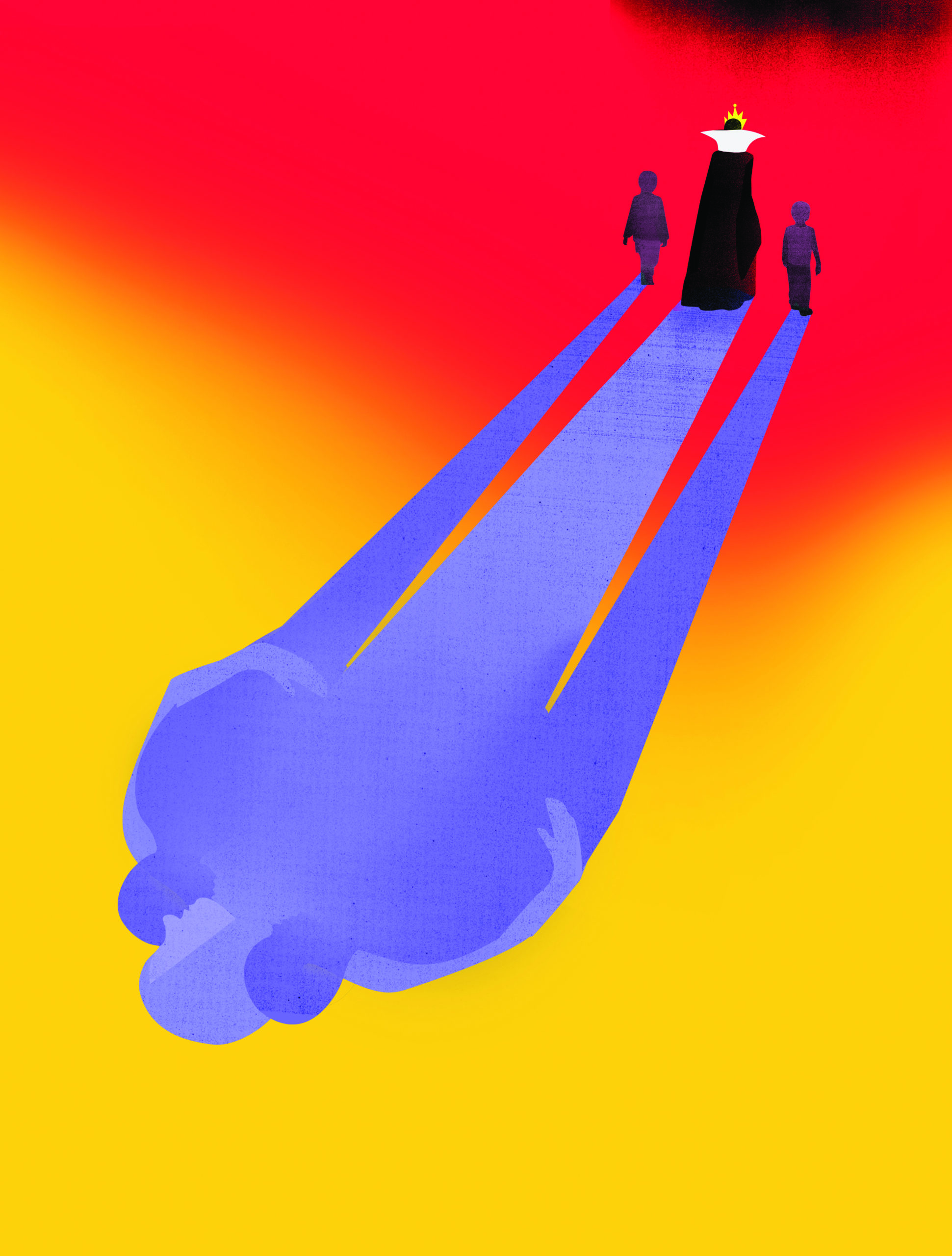
Stepmothers: From Sinister Stereotype to Contemporary Counter-Narratives
What's it like for this thirtysomething Jew raising stepdaughters? Silver tells the girls her own stories, then learns some truths from other stepmothers coming out from under the sinister stereotype.
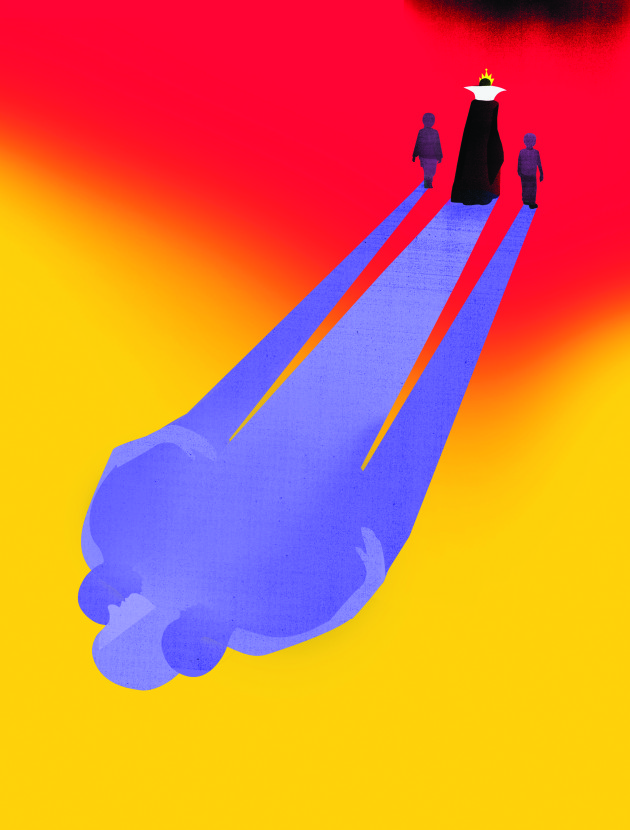
Art by Hila Peleg.
My Stepdaughters Want to Know My Stories
This is our nightly ritual: Book reading. Lights out. Massages for one while their father wrestles with the other. Bed switch. Finger-stories traced on their backs. Tuck in. Good night. Love you. See you mañana, iguanas. We’ve been on Harry Potter, a few pages a night, for several years. Before Harry Potter, the girls’ bedtime books came from an arsenal of my own childhood favorites: Anne of Green Gables, the Little House series, A Wrinkle in Time, Heidi. I had loved those characters in my youth, and always dreamt of sharing them with my kids. A number of years ago, when the girls didn’t show interest on their own, I took matters into my own hands, and our nightly pattern became the elaborate routine it is now. Even during a year-long rocky patch when Rose was around 11 or 12 — at the time, “rocky” would have felt like an understatement, but that’s another story for another time — we’ve followed this routine. Our every-other-night events have been like royal icing for my relationship with the kids — part sweet, part glue. I’m wary of unsolicited advice, particularly when it comes to parenting, but if there’s a silver bullet for positive stepmother/daughter relationships, this bedtime stuff may be it.
The night before I flew alone to my east coast family’s Passover seders, I tucked my California kids in for our usual bedtime ritual. In the moonlight, I traced pictures of jumping horses over Rose’s shoulder blades. She’s recently quite literally back in the saddle: an ankle injury kept her from riding since last summer. Her heart is set on an autumn equestrian show, and for years she’s requested these drawings that she uses as visualization meditations. I cantered my fingers over her moonlit back, galloped over a fence jump, and another, gaining speed. After a few times around the course, I pulled the blanket to her shoulders and straightened it over her feet. Sweet dreams, Roo. I moved to Shiloh’s bed on the shadowy side of the room. Shiloh prefers unicorns and other mythical creatures in her back-drawings-stories, but will often tolerate a story from my childhood instead.
When parents tell stories from their personal history, the stories fold into the family’s folklore. Parents share childhood memories with their children, and the history knits into the fabric of the children’s understanding of who they are and where they came from. Yet, when I became a stepmother — a singularly unique type of outsider who, arguably, disturbs the established family harmony by her mere presence — I was surprised to find the girls asking me to share my stories. Their questions were less about understanding themselves and more about trying to know me, this woman who’d been dating their dad for two years and was now asking them to pick up their socks from the living room. During our nightly routine, the girls pummeled me with questions that seemed never-ending. In truth, I hoped they were. No one had ever — ever — asked me these things: What did I wear in fifth grade? What was my favorite memory of all time? What was my worst day ever? They giggled and pressed for details about 1980s grade-school fashion. Inevitably, as I scoured my memory’s archives, a simple fashion detail led to other, more meaningful treasures. They wanted to know a zillion long-forgotten things, and on their days away from us, I’d prepare for their curiosity by delving into thoughts I hadn’t accessed for ages. Though my stories might not knit into Rose and Shiloh’s fabric of self-understanding, remembering them strengthened the stitches of my own.
On the night before I left for Passover, after their father went downstairs, I massaged the knot in Shiloh’s shoulder. She calls it a grump, a constant lately from her long hours bent over sketch books she fills with anime drawings. With the upcoming trip in mind, I wracked my memories for some old family anecdote to share with the girls. Largely now unbidden, I wedge in frequent stories about my childhood in an attempt to fill my own gaps among the branches of this new family tree. Whether they request the stories or not, I’ve found that I need to share pieces of myself with them, want to thread my stories into theirs. Without biological children of my own, I hang off the side of Rose and Shiloh’s tree like a forkless appendage grafted on later. It’s a wonky tree, but a common enough variety. When I try to envision our particular version, the kids swing from a bandaged broken limb between their mother and father. I like to think that despite the bandages, the added branches from me and (on their mother’s side) their stepfather and stepbrothers make the tree more lush.
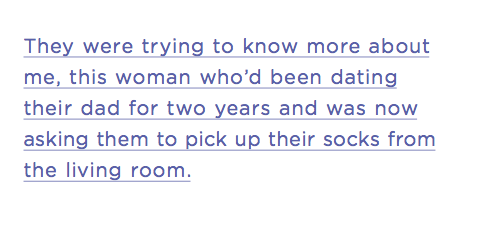 That night I wondered what I could tell the girls that might hold their interest. After our many years together, their pointed curiosity in my past has dulled, but they do like a good story. I thought to tell them about the atonal rendition of songs from our family haggadah, passed down from one tone-deaf generation to the next, until finally landing on me and my cousins, who are all, miraculously, skilled musicians, yet only versed in those inherited tottering melodies.
That night I wondered what I could tell the girls that might hold their interest. After our many years together, their pointed curiosity in my past has dulled, but they do like a good story. I thought to tell them about the atonal rendition of songs from our family haggadah, passed down from one tone-deaf generation to the next, until finally landing on me and my cousins, who are all, miraculously, skilled musicians, yet only versed in those inherited tottering melodies.
But Rose and Shiloh barely know my cousins, aunts, and uncles; they’ve only met my grandparents once, at the wedding; my brother and mother a handful of times. My mind wandered over Sukkot, Hanukkah, Passover, Yom Kippur, etc. While I have largely shaken off the Conservadox traditions on which I was raised, their rituals and prayers are ingrained in me, and my extended family memories linger over the shared holiday meals. My grandpa still calls me his Ashrei girl, because in third grade I sang it from the bima as a Hanukkah gift to him; though it has been decades since my summers at Camp Ramah, I can still whip out a decent birkat hamazon. But these prayers and customs would ring empty to Rose and Shiloh. They’ve learned about Judaism in a sideways fashion from me and from their stepfather. It’s a different sort of knowing: a step-knowing.
Along with unicorns and Harry Potter creatures, I rank children, mothers, and stepmothers among the inventory of mythological creatures. Shiloh would disagree. Oh, Artá, she’d say, because she’s a child, and that’s what she’s called me since she was 5, but I suppose it depends on who is telling the story. Like all mythological creatures, some are good, some are bad, some have moral standing yet to be determined. We all know where the stepmother falls on that spectrum. Just a month ago, the second grade at Shiloh’s school staged a fairy tale play. It was in the middle of my workday so I didn’t attend, but my husband texted me, Wicked stepmother strikes again. I wondered how many children in the audience or in the play later went home to their own stepmothers. I wondered how many would one day become stepmothers. According to researcher Allison Christian, the social stigma that comes from the perpetuation of the wicked myth significantly affects the stepmothers’ self-esteem and the whole family relationship. Sadly for the whole family, the stepmother’s reputation precedes her.
It would be impossible to pinpoint the exact moment I understood that stepmothers and their ilk — wolves, witches, ogres, and the like — are tolerable only when kept far from the first family; that is, the kind fathers, good mothers, and innocent children. A while ago, I stumbled on a dissertation that asserted that the “outsider” status of the Brothers Grimm antagonists reflected the 18th- century regional values that likewise ostracized Jews and Africans. Though I know that neither a premonition of my stepmother future nor my Jewishness had anything to do with the casting, when I was young and my second grade staged our own fairy tale play, I played the witch. Rose and Shiloh know this story: how my mother brushed my long hair up into a knotty mess, how she blackened out my front tooth with make-up, and the one line I still remember: Little mousey, little mousey, who’s that nibbling at my housey? When I retell the story now, they recite it with me, and that memory has become a tiny stitch in our fabric. I don’t think the girls have connected the fact that I’m a stepmother now with the character I once played in Hansel and Gretel, a fairy tale that famously conflates stepmother and witch (in the Brothers Grimm tale, the witch and evil stepmother die in the same instant). Yet, with the dogged stereotype pawing at the movies they watch, newspaper headlines (just Google “news headlines stepmother”), and popular consciousness, I’ve walked this role in my girls’ lives like I once walked the balance beam in gymnastics: steady, straight, and careful. That’s not necessarily a bad way to parent, but I’ve found, in the few times I’ve faltered, that there is very little room for stepmother error.
Barbara Kingsolver has an essay, “Stone Soup,” in which she calls families like ours binuclear. This idea rings more honest to me than the lately-popular term blended. I question blended’s trendy nomenclature, which attempts to brush over the inherent challenges that come when an outsider enters an already-built family unit. Families like ours are not a smoothie, all blended together in a uniform, palatable pastel. We are four people, two of whom fell in love midlife after a lot of personal history. This history includes my own, which, sadly, did not result in children, and my husband’s, which did. We are two people who share values, values neither of us necessarily share with our exes, but values that his — now our — children must navigate with varying degrees of success as they travel between households.
To Rose and Shiloh’s credit, they are pretty sure-footed, and kids, in general, know how to adapt. And to my husband and his ex-wife’s credit, our unusual shared custody schedule — in which the kids go back and forth every day — works remarkably well. By waking up at our house on Sunday and going to sleep at their mother’s, and then doing the opposite on Monday, etc., they see both primary parents almost every day. I’ve rarely witnessed moody transition crises so common in families with longer custody stays. In Kingsolver’s binuclear term, our two homes are like two suns in one solar system. Our gravitational forces draw the kids back and forth, but they never get lost in deep space.
I may not be their mother, but Rose and Shiloh are my kids. Just as they once cared to know all about me, I cared to know everything about them. But having a binuclear family means, among other things, a certain amount of unknowing. I have very little knowledge of bedtime rituals at their mom’s. And, likewise, many of my childhood customs are sidelined by the customs of their early childhood, from before I arrived. Christmas, for instance. It’s a holiday I’ve celebrated almost yearly in some fashion, ever since my early twenties, when my college boyfriend and I visited his parents. But with the girls and my husband, I now experience Christmas full blast. Every year, the three of them decorate our home with relicts from my husband’s family, baubles the girls have hung from the mantel for as long as they can remember, and a tree.
The tree, which entered the picture only a few years ago, surprised me with its force. It appeared the Christmas after my husband’s beloved mother passed away. The loss of her must have triggered his need to share this classic custom of his childhood with his daughters. I couldn’t say no — why would I? Yet it felt strange, given my own upbringing. I grappled with a new uncomfortableness at being an outsider to this family: a stepmother, yes, but also a Jew, albeit unpracticing. That December, it’d been years since I had earnestly lit the Hanukkah candles, yet I dug up the two menorahs and one of many unopened candle boxes. On the first night of the holiday, I stood alone inside a dark kitchen window in our quiet house. My husband pulled in the driveway shortly thereafter to candles shining through the glass. The next night, he stood back while the girls choose which colored candles to light, the way I did when I was their age. When Rose and Shiloh each held the shamash to the other wicks, I started the prayers. Surprisingly, they joined me. I hadn’t known that the girls knew the Hanukkah prayers, but they’d learned them at their mom’s from their stepfather and stepbrothers.
According to Jewish law, women have very few obligations. While having children is not one of them, the stories and prayers on which I was raised left no question that it was expected I would. One story that won’t make it into the girls’ bedtime ritual is from this spring’s Passover trip. Before we all flew back to our respective states on the morning after the second seder, four generations of us, from toddler to near-nonagenarian, gathered at my aunt and uncle’s house for plates of my grandmother’s matzah brie. I am the oldest of my generation; my mother is the oldest of hers. I fondly remember most of my great-grandparents, and miss them, the last of whom passed away in my 12th grade year. My children could be considered the first of their new generation. However, though Rose and Shiloh landed in my life some time ago, my cousin’s baby, a beautifully delightful toddler, is the first family birth. My grandmother is over the moon at her new status as great-grandmother. I understand this, partly because Rose and Shiloh arrived already half-grown, but particularly because California is very far from where my grandparents live. Chances are great that my husband and I won’t be flying the four of us to visit, so in all likelihood, my grandmother and the girls will never meet again. Still, it bothers me that my grandmother hasn’t learned my children’s names. It bothers me more that she doesn’t consider them my kids. Shiloh was diagnosed with Type 1 diabetes last year, and when my grandmother thought to inquire about her health on the last day of my trip, she said, “How’s your husband’s daughter, the one with diabetes?” But my grandmother is in her eighties. What use is there in questioning why she doesn’t consider me a parent to the girl whose blood sugar I’ve checked at midnight, whose buttocks I’ve shot with a syringe of insulin? What use is there in barging in with unsolicited stories about Rose’s horse show?
Stepmothering is a different sort of mothering. Though I once lamented the experiences I missed with Rose and Shiloh — the early years, the nights at their mom’s — over time I’ve realized that if certain pieces of this role are mind-bogglingly difficult, other bits come easy. It’s no secret that parenting runs through the gamut of personal and shared frustrations and joys. Stepparenting and biological parenting in a binuclear family are variations on the theme. In her paper titled “The Uses of Fairy Tales in Psychotherapy,” marriage and family therapist Bette U. Kiernan writes, “Stories are important in our lives. We gain a sense of who we are through narratives, the telling of stories to ourselves and others about what has happened to us. We form our identities through integrating our personal family histories with the legends of our culture.” Sometimes, though, the legends carried by our culture are at odds with our personal family structures. There’s no more obviously mistaken legend than that of the stepmother. But if I want it changed, I need to write it. Night by night, every other day, this is what we’re doing up in Rose and Shiloh’s bedroom under the moonlight: reading and writing our own stories of our complicated and loving family.
Who’s Really Under that Wicked-Stepmother Cape?
It’s nearly impossible to see the word stepmother without stifling the impulse to add its accompanying pejorative adjective. The persistent stereotype surfaces immediately, even if we ourselves are benign stepmothers. Using the most scientific method of research — an informal survey on Facebook — I polled from friends around the world for their gut feelings.
Sarah from New Jersey: “My 4-year-old thinks stepmother is akin to witch.”
Laura from North Carolina: “I have negative Disney associations with stepmom that override my own experiences as a stepmom. Stepdad stays more varied, without the negative connation.”
Amy from California explained how the compound word is composed in American Sign Language: fake and mother.
A friend from Venezuela responded, “Madrastra. Sounds like the Wicked Witch of the West.”
Natalie, from Belarus, pronounced it macheha. “The sound of it is quite evil. And,” she added, “the plant coltsfoot is called in Russian, “mother-and-stepmother,” because its leaves are warm on the one side and cold on the other.”
“There’s no way to avoid the wicked stepmother,” says a friend of mine, stepmother of two who, like all the other women I spoke to for this report, requested that I not use her name. “It’s a terrible trope in our culture,” she added. Folklorist Maria Tatar notes that the oldest known Cinderella story actually comes from China, circa 850 b.c.e. Patricia A. Watson writes in Ancient Stepmothers: Myth, Misogyny and Reality that malevolent stepmothers appear frequently in both ancient Roman and Greek literature. No matter how far back its roots go, the modern iteration of the stepmother has gained greater momentum by Disney via those horrifyingly mean creations like the jealous queen in “Snow White,” the deranged mother-substitute in “Tangled” (their version of Rapunzel), the Ur-evil stepmother in “Cinderella.”
Archetypal characters like these can offer a framework for deeper understanding of our feelings. In The Stepmother in Fairytales: Bereavement and the Feminine Shadow, Jungian analyst Jacqueline Schectman explains that every person has the “stepmother” in her psyche, characterized by the punishing and withholding aspects that arise when the “good mother” aspects retreat.
But a feminist take on the stepmother figure has to point us to the demonization of a stock female figure, an image far removed from most families’ experience. Countervailing present-day stepmother narratives are hard to find, though, despite the ubiquity of stepfamilies today, when about one in six American children lives in a family with stepparents or stepsiblings. Why the reluctance to talk about these real-life experiences?
For all parents, disclosing information about children raises complex issues of the children’s safety and right to privacy, among other concerns. When the parent is a step, the challenges deepen, and include questions about who owns or is entitled to speak about the children/stepchildren. Who has the right to claim the story? Who determines the boundaries? Layer upon delicate layer, real stepmother narratives are often buried beneath the stories of the original family.
And because of the delicate and complicated feelings involved, there is often silence, a reluctance to share what’s going on if the surface of the family’s life seems smooth. “I don’t want to be complicit in the silencing,” said one of the stepmothers I spoke to, “but these are my kids, my family. The silencing goes so deep because you’re working very hard to create a new whole,” said this woman; we’ll call her Shira. “It’s a complex relationship for all of us. When you have stepchildren plus children you have birthed all in one family, there is no one who is not affected.”
“It’s a funny story, where the more of a success it is, the less likely people want to talk about it. It’s an underground story. The totality of the story is not mine,” said Anna, 40, who first met the two children who are now her stepchildren when she was in her mid-thirties; she has since had a baby with her husband, the father of her stepchildren. Of the fairy tale stepmother trope, she says, “More and more, it’s not a figure people recognize.” The stereotype has never affected her psyche, she says, because it feels more like it’s the manifestation of fears from another time in history. “Some stepparents are terrible. But some people are just terrible parents. People can be terrible kindergarten teachers or massage therapists or prison guards.”
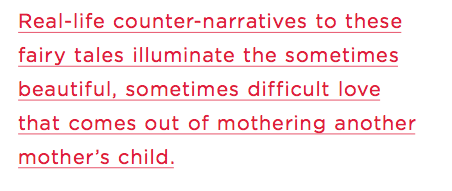
Though Jewish folklore doesn’t carry the precise wicked stepmother stereotypes, stories like Sarah/Hagar and Leah/Rachel are, at their essence, stories of wives and children competing for a father’s love.
This perceived scarcity of the father’s love plays out over and over in stepmother stories, from Hansel and Gretel to modern families. In my own early years of stepmothering, I was often literally squeezed out as my younger stepdaughter wriggled her little body between her father and me, and claimed his hand with both of hers. Now, at 41, I recall feeling frustrated and slighted, then humbled when I remembered that the child was only six years old and adjusting, as best she could, to the space I now occupied in her family.
By their very existence, stepmothers signal a condition of loss. The English prefix “step” used in these second-family relationships derives, in fact, from steop-, found in the word steopcild, which means “orphan,” and comes from astiepan/bestiepan, which means “bereave.” Bruno Bettelheim’s classic, The Uses of Enchantment, posits that fairy tales help children understand the losses and changes engendered by real-life events. Nowadays the stepmother-stepchild relationship is more frequently formed after a divorce and remarriage, rather than as a consequence of the death of the biological mother as in centuries past. Either way, a stepparent represents some disintegration of the family of origin.
The reality, Anna admits, is that every stepparent knows that she or he is the odd person out. A childless stepmother who enters an already-built family unit has very little power in the culture of a new household. Stepmothers must navigate their own course through the choppy waters of post-divorce resentment, ex-spouse communication, and biological loyalties. In all of this complexity, the needs of the stepmother are often overlooked.
Shira recalls that at 30, when she became the stepmother to her husband’s child, she really needed emotional support as she adapted to this role in her new insta-family. Compounding things, her own parents resisted embracing her stepson as their own grandchild. “I wish my mother could have been more supportive of me as I raised him. By distancing herself from him, she didn’t give me a safe space to talk about the challenges.” Her friends, and her synagogue community, helped combat the isolation she initially felt as a young stepmother; in the 20 years since, she has found herself helping other women through similar circumstances. “You need someone who will accept you with all your complicated feelings. The complicated feelings are normal.”
“How do you craft a family?” is a question she’s often asked. This is a question every parent faces as they create family rituals and experiences. “But,” Shira contends, “in step-families there’s another reality that’s under the table, the reality about the step part of their family. That reality — and how the husband and wife talk about it — is a constantly shifting landscape, reflecting both their own growth and the growth and maturity of the children.”
One of the common challenges is that the children, already fragile from the breech they’ve experienced in the severance of their first family, can feel displaced by the arrival of a stepmother. As Anna told me, after a divorce the adults represent household destabilization, and the introduction of another adult does not make the children then feel stable. Remember all those fairy tales? The children often resent sharing their biological parent’s affections and attention with a stranger. In “Snow White,” the stepmother becomes jealous and murderous when the protagonist reaches puberty, which Bettelheim says turns around the classic phenomenon, diffusing a child’s guilt at subconsciously wishing to be rid of a parent as the child moves into and through adolescence. Whether the displacement of affection the children feel is real or imagined, there is no way to avoid the truth, which is that a new stepmother, in some ways the alien in the family, does disturb the harmony of a household.
Yet, despite the difficulties, as an adult in the household who is neither mother nor father, a stepmother can be the beneficiary of unique rewards. As an outsider, her interactions and emotional connections with the children are particular to her. “Different kids are looking for different things,” says Anna, who is close with her stepchildren. She says that her stepson, now 5, appreciates seeing his father in a happy relationship. Her stepdaughter, 11, seems to want to figure out what kind of a woman her father connects with. Some children are looking for a replacement parent. But many, particularly those in shared custody, want and need something else. A mentor? A caregiver? Something more akin to “godmother”?
Before Shira and her husband had the children “we gave birth to,” she “walked in thinking, I could be this kid’s mom. I am very much a mothering presence in the household — the emotional center of our family, the one who keeps everyone together. That’s the culture of our home. The family stuff, and the Jewish family stuff, is our culture. But I had to reconcile myself to the fact that I wasn’t, and I couldn’t be, because my stepson had a mother.”
“Even the language we use is complex. I say ‘This is my oldest child’. And to people who don’t know, we are just ‘the parents’ — and I bristle at saying ‘stepson’. The truth is that I feel he is my child. But there is also that other truth…”
In fact, one of the trickiest aspects of stepmothering comes not from the relationship with the child, but the relationship with the biological mother. Often, communication between the two households gets as mangled as a game of telephone. The dregs of divorce can cast a sheen of suspicion and toxicity between the step- and biological mothers, stressing the relationships all around. Similarly, one or both households commonly vie for the children’s affections through presents. Shira recalls her son coming home from a typical Sunday visit with his biological mother, carrying a gigantic bag from a toy store, and thinking, “She gets to be the fun parent, and we get the doctor appointments and school.”
“Sometimes you’re just cast in that role,” says Shira. “That’s what you get. And if that’s what I got, I just wanted to do the best I could do with that. I wasn’t perfect, and I didn’t parent perfectly with any of my kids. But there is no perfect. Perfect is not realistic. However, I’m glad that I could be a safe landing place. And I think that, together, my husband and I made an amazing home for all of our children. I see that as a remarkable achievement. That is the most core Jewish value I can think of.”
Supplementing the helpfulness of personal stories from experienced stepmothers like Shira and Anna, the Jewish Social Service Agency serving Maryland, DC, and Northern Virginia offers a strategy “tip sheet” for stepparents. Among their suggestions are reminders that children depend on parental permission to grieve the loss of their nuclear family unit, that the children’s relationship with their biological mother is important for the child’s healthy development, and that on average it takes two or three years to build the bonds and secure foundation for a stable new family.
The realities are that the “wicked” stereotype lurks in our collective psyche; that society demands stepmothers be mothering, but not the mother; and that stepchildren stress a remarriage. Real-life counter-narratives to the fairy tale trope illuminate the sometimes beautiful, sometimes difficult love that comes out of mothering another mother’s child.
Arielle Silver won the 2016 AULA Library Research Award for her critical research thesis, “Wicked, Selfish, and Cruel: An Inquiry into the Stepmother Narrative.” Her work has appeared in Moment, Brevity, Gulf Stream, Role Reboot, and Lunch Ticket, where she serves as editor in chief.

